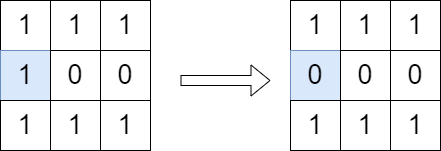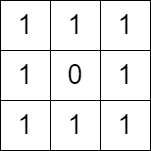Welcome to Subscribe On Youtube
2556. Disconnect Path in a Binary Matrix by at Most One Flip
Description
You are given a 0-indexed m x n binary matrix grid. You can move from a cell (row, col) to any of the cells (row + 1, col) or (row, col + 1) that has the value 1. The matrix is disconnected if there is no path from (0, 0) to (m - 1, n - 1).
You can flip the value of at most one (possibly none) cell. You cannot flip the cells (0, 0) and (m - 1, n - 1).
Return true if it is possible to make the matrix disconnect or false otherwise.
Note that flipping a cell changes its value from 0 to 1 or from 1 to 0.
Example 1:

Input: grid = [[1,1,1],[1,0,0],[1,1,1]] Output: true Explanation: We can change the cell shown in the diagram above. There is no path from (0, 0) to (2, 2) in the resulting grid.
Example 2:

Input: grid = [[1,1,1],[1,0,1],[1,1,1]] Output: false Explanation: It is not possible to change at most one cell such that there is not path from (0, 0) to (2, 2).
Constraints:
m == grid.lengthn == grid[i].length1 <= m, n <= 10001 <= m * n <= 105grid[i][j]is either0or1.grid[0][0] == grid[m - 1][n - 1] == 1
Solutions
Solution 1: Two DFS Traversals
First, we perform a DFS traversal to determine whether there is a path from $(0, 0)$ to $(m - 1, n - 1)$, and we denote the result as $a$. During the DFS process, we set the value of the visited cells to $0$ to prevent revisiting.
Next, we set the values of $(0, 0)$ and $(m - 1, n - 1)$ to $1$, and perform another DFS traversal to determine whether there is a path from $(0, 0)$ to $(m - 1, n - 1)$, and we denote the result as $b$. During the DFS process, we set the value of the visited cells to $0$ to avoid revisiting.
Finally, if both $a$ and $b$ are true, we return false, otherwise, we return true.
The time complexity is $O(m \times n)$, and the space complexity is $O(m \times n)$. Where $m$ and $n$ are the number of rows and columns of the matrix, respectively.
-
class Solution { private int[][] grid; private int m; private int n; public boolean isPossibleToCutPath(int[][] grid) { this.grid = grid; m = grid.length; n = grid[0].length; boolean a = dfs(0, 0); grid[0][0] = 1; grid[m - 1][n - 1] = 1; boolean b = dfs(0, 0); return !(a && b); } private boolean dfs(int i, int j) { if (i >= m || j >= n || grid[i][j] == 0) { return false; } if (i == m - 1 && j == n - 1) { return true; } grid[i][j] = 0; return dfs(i + 1, j) || dfs(i, j + 1); } } -
class Solution { public: bool isPossibleToCutPath(vector<vector<int>>& grid) { int m = grid.size(), n = grid[0].size(); function<bool(int, int)> dfs = [&](int i, int j) -> bool { if (i >= m || j >= n || grid[i][j] == 0) { return false; } if (i == m - 1 && j == n - 1) { return true; } grid[i][j] = 0; return dfs(i + 1, j) || dfs(i, j + 1); }; bool a = dfs(0, 0); grid[0][0] = grid[m - 1][n - 1] = 1; bool b = dfs(0, 0); return !(a && b); } }; -
class Solution: def isPossibleToCutPath(self, grid: List[List[int]]) -> bool: def dfs(i, j): if i >= m or j >= n or grid[i][j] == 0: return False grid[i][j] = 0 if i == m - 1 and j == n - 1: return True return dfs(i + 1, j) or dfs(i, j + 1) m, n = len(grid), len(grid[0]) a = dfs(0, 0) grid[0][0] = grid[-1][-1] = 1 b = dfs(0, 0) return not (a and b) -
func isPossibleToCutPath(grid [][]int) bool { m, n := len(grid), len(grid[0]) var dfs func(i, j int) bool dfs = func(i, j int) bool { if i >= m || j >= n || grid[i][j] == 0 { return false } if i == m-1 && j == n-1 { return true } grid[i][j] = 0 return dfs(i+1, j) || dfs(i, j+1) } a := dfs(0, 0) grid[0][0], grid[m-1][n-1] = 1, 1 b := dfs(0, 0) return !(a && b) } -
function isPossibleToCutPath(grid: number[][]): boolean { const m = grid.length; const n = grid[0].length; const dfs = (i: number, j: number): boolean => { if (i >= m || j >= n || grid[i][j] !== 1) { return false; } grid[i][j] = 0; if (i === m - 1 && j === n - 1) { return true; } return dfs(i + 1, j) || dfs(i, j + 1); }; const a = dfs(0, 0); grid[0][0] = 1; grid[m - 1][n - 1] = 1; const b = dfs(0, 0); return !(a && b); }